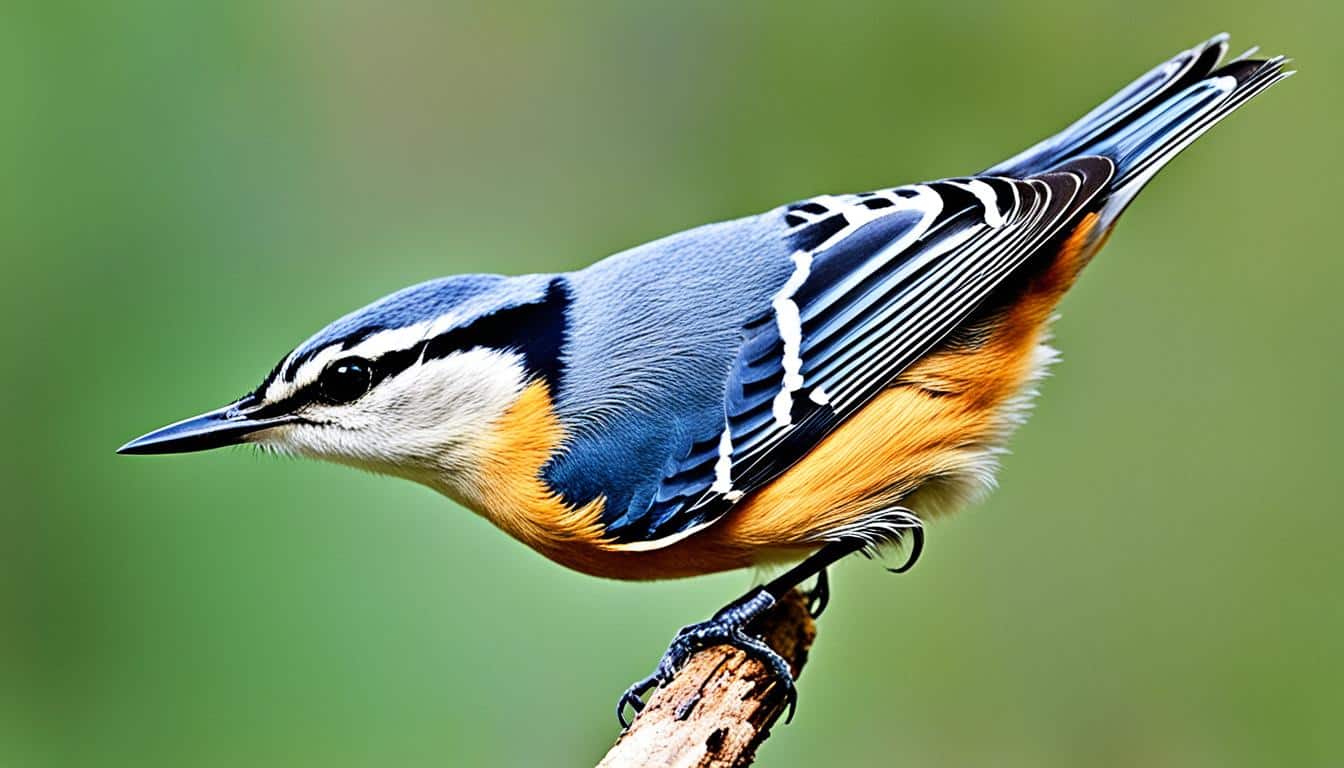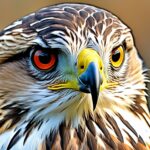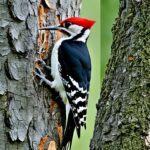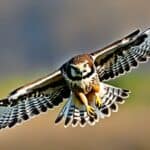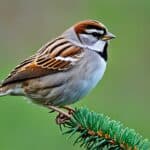Ever wondered how to tell the nuthatches apart? There are four common types in North America. They move quickly and live in various places, making them a fun challenge for bird lovers.
Getting to know nuthatches can make birdwatching even more exciting. You’ll see White-breasted, Red-breasted, and Pygmy Nuthatches all over Canada and the US. The Brown-headed Nuthatch prefers the southeast. Now, let’s explore how to spot them here in the USA.
Introduction to Nuthatch Species in the USA
Fans of birds are often drawn to nuthatches because of their lively nature. It is key to know a bit about their common features, where they live, and how they act. This info can make watching birds more fulfilling. Plus, it helps people tell the different types of nuthatches apart.
General Characteristics of Nuthatches
What makes nuthatches stand out is how they move on tree trunks. They can go upside down or sideways with no trouble. You can spot them by their strong bodies and short tails. Also, their beaks are good for cracking open food like seeds and bugs. It’s the little differences in these features that help spot the different nuthatch types.
Habitats and Distribution
Nuthatches are found in various places, from forests with needle trees to those with broadleaf trees. For example, you might see White-breasted Nuthatches more in areas with broadleaf trees. Meanwhile, Red-breasted Nuthatches prefer places with trees like pines. Plus, Pygmy Nuthatches like pine forests out west, while Brown-headed Nuthatches live in the south near the coast. Knowing where they like to live is important for telling them apart.
Nuthatch Behavior and Diet
Nuthatches are interesting to watch because of their calls and how they eat. You can often find them at bird feeders in people’s yards. They eat things like bugs, seeds, and nuts, but the exact types of food can vary by the season. Each nuthatch has its own way of eating and food they like, which helps in identifying them. Watching how they act around food can give good hints about what kind of nuthatch they are.
White-breasted Nuthatch
The White-breasted Nuthatch is a standout bird in the USA. It’s known for its special look. This includes a white face and underparts, a black cap, and blue-gray upperparts. Look for these features to spot a White-breasted Nuthatch when bird watching.
These birds live in old forests filled with oak and hickory trees. You might see them if you visit places like southern or coastal Maine. They also visit bird feeders in the winter. This makes them easy to watch, especially when normal food is hard to find for them.
White-breasted Nuthatches have interesting ways of acting. They hide food, such as nuts and seeds, in tree bark. This helps them survive during the winter. Their quick “yank-yank-yank” calls stand out, too.
Let’s look at some key points to better know the White-breasted Nuthatch:
| Aspect | White-breasted Nuthatch | General Nuthatch Species |
|---|---|---|
| Physical Attributes | White face, black cap, blue-gray upperparts | Varies by species; generally small, compact bodies, strong bills |
| Habitat Preference | Mature deciduous forests | Coniferous and deciduous forests |
| Behavior | Caching food, nasal “yank-yank-yank” call | Intense feeding, varied calls |
By paying close attention to these details, you can get better at telling White-breasted Nuthatches apart. This also helps you understand their place in the nuthatch family in the USA. Learning about them makes bird watching more interesting.
Red-breasted Nuthatch
The Red-breasted Nuthatch is a stunning bird that captivates many. It stands out with its unique features. Bird enthusiasts and experts alike enjoy learning about this species through its physical traits, where it lives, and what it does.
Appearance and Size
Spotting the Red-breasted Nuthatch is easy due to its bold coloring. It has a deep red breast and a slate-gray back. It also has an eye-catching black cap and stripe over its eye. This makes it distinct from other nuthatches. Plus, it’s smaller, measuring around 4.5 inches long.
Preferred Habitats
Knowing where the Red-breasted Nuthatch likes to live can make it easier to find. It loves coniferous forests, especially spruce and fir trees. It also lives in mountain areas among dense, green woodlands. These environments are key to its survival and role in nature.
Behavioral Traits
This bird’s unique behaviors are also part of what makes it special. It can climb down tree trunks headfirst, a skill not many birds have. This ability helps it find food like insects and seeds under the bark. It also hammers food into tree crevices, showing off its cleverness.
In terms of sound, the Red-breasted Nuthatch is known for its quick, nasal calls. These quick sounds set it apart from other birds. They can be helpful in identifying this bird by sound. So, keep an ear out for these distinct calls.
Pygmy Nuthatch
The Pygmy Nuthatch is a small yet fascinating bird, notable for its unique habits and habitats. It’s just 4 inches long and has a unique set of vocalizations, which include many chirps and high calls. These birds like being with others, seen foraging in close groups.
The bird’s look is key to recognizing it. It has a grayish-blue body, a brown crown, and white undersides. This unique coloring helps bird watchers easily spot them. They move quickly and often climb up and down trees, which catches the eye.
They mainly live in pine forests of western North America, from Canada to Mexico. These areas offer plenty of food and places to nest. Knowing this helps you find them in nature, especially with a detailed bird guide.
| Characteristic | Pygmy Nuthatch |
|---|---|
| Size | 4 inches |
| Plumage | Grayish-blue body, brown crown, white underparts |
| Habitat | Pine forests |
| Vocalizations | Chirps and high-pitched calls |
Learning about these features and using a good bird identification guide will make your birdwatching better. You’ll be able to pick out the special Pygmy Nuthatch among its surroundings.
Brown-headed Nuthatch
This part highlights what’s special about the Brown-headed Nuthatch. It’ll help you spot this bird easily. Plus, it’ll show how it’s different from other nuthatches.
Visual Identification Markers
Looking at the colors can help you find the Brown-headed Nuthatch. It has a brown cap, white cheeks, and a white belly. Its wings and back are a pretty blue-gray. With its small size and short tail, you can tell it apart from other nuthatches.
Geographic Range
The Brown-headed Nuthatch lives in the southeast of the United States. It loves pine forests. States like Florida, Georgia, and the Carolinas are its home. You can see them all year in their favorite places.
Feeding Behavior
Knowing how the Brown-headed Nuthatch eats can help you find it. It loves pine seeds and insects. Watch for it poking at pine cones and bark. It’s known to use bark as a tool to get insects out. Seeing this means a Brown-headed Nuthatch could be near.
Distinguishing Features Among Nuthatch Species
Recognizing various nuthatch types in the USA includes noticing their unique traits. This guide will boost your nuthatch identification skills by looking at color patterns, size and shape, and behavior.
Color Patterns
Each nuthatch has its own color patterns. The White-breasted Nuthatch has a white face and belly and a black top. On the other hand, the Red-breasted Nuthatch sports a red chest and a black streak over its eyes.
Size and Shape Differences
Size and shape help tell nuthatch types apart. The White-breasted Nuthatch is the biggest, with a broad body and large bill. The Pygmy Nuthatch, however, is tiny and has a short tail. These details are key for accurate identification.
Unique Behaviors
Distinct behaviors add clues to identifying nuthatches. |
The White-breasteds travel head-first down trees. The Pygmy Nuthatch enjoys being with others, flying in groups. The Red-breasted Nuthatch is loud and protective of its territory. Knowing these actions is crucial for spotting nuthatch species.

| Feature | White-breasted Nuthatch | Red-breasted Nuthatch | Pygmy Nuthatch |
|---|---|---|---|
| Color Patterns | White face, black cap | Rusty-red breast, black eye stripe | Grayish-blue upperparts, pale underparts |
| Size | Largest | Medium | Smallest |
| Shape | Robust body, larger bill | Medium-sized, slender build | Short tail, compact |
| Unique Behaviors | Head-first descent | Aggressive territorial calls | Highly social, flocking |
How to Use Calls for Nuthatch Identification
Listening to bird songs is key for telling nuthatch species apart. You’ll find out how to recognize nuthatches by their calls here. Each nuthatch type has its unique call. With time, birdwatchers learn to spot these differences.
White-breasted Nuthatches are known for saying “yank-yank”. Their sound is loud, nasal, and quick. By listening for this sound, spotting them gets easier.
But, Red-breasted Nuthatches also say “yank-yank”. Their version is quicker and higher. Understand these differences to boost your nuthatch identification skills.
Here’s a chart for easy comparison:
| Species | Call Description | Pitch | Speed |
|---|---|---|---|
| White-breasted Nuthatch | “Yank-yank”; nasal series | Lower | Moderate |
| Red-breasted Nuthatch | “Yank-yank”; high-pitched | Higher | Rapid |
Learning nuthatch calls makes your birdwatching better. When you hear “yank-yank” sounds, think about pitch and speed. This can help you spot specific nuthatch species.
For great birdwatching, always pause to listen and note down calls. This habit will improve your sound-based nuthatch identification. You’ll become a keener watcher.
Seasonal Changes and Migration Patterns
For bird lovers, knowing about nuthatch migration is key. The behavior of American nuthatch species changes with the seasons. This influences where they are found.
The Red-breasted Nuthatch is quite different. They make movements called irruptions. These are not always easy to predict. Food and weather lead them to places outside their usual spots. This surprises bird watchers with chances to see them in new places.
Meanwhile, some nuthatches are more consistent. They stick to a pattern that’s easier to guess. For example, the White-breasted Nuthatch is mostly found in the same areas all year. It might move a bit but not too far.
Here’s a quick comparison of two nuthatch species and their migration behaviors:
| Species | Migration Patterns | Seasonal Behavior |
|---|---|---|
| Red-breasted Nuthatch | Irruptive, influenced by food scarcity and climatic factors | Can move into different regions far from their usual range during winter |
| White-breasted Nuthatch | More stable, minor local movements observed | Generally remains within the same range year-round |
Understanding nuthatch migration and seasonal life lets you identify them better. This adds to the joy of birdwatching throughout the year.
Nuthatch Species Interaction with Other Birds
Understanding nuthatch species’ interactions with other birds is great for bird fans. It helps with accurate identification of bird species. Nuthatches often mix with other birds in groups, especially outside breeding seasons. They help the group by hunting together and warning about dangers. Watching how they do this can teach us a lot about their lives and the part they play in the environment.
Nuthatches have behaviors that make them unique from other birds when in these mixed groups. They climb up trees looking for food headfirst, not like most birds. This way of searching for bugs, along with how quickly they move and peck, makes them interesting to watch. Also, they make a distinct sound that helps tell they are around just by hearing them.
Nuthatches and woodpeckers have a cool teamwork. Both look for the same food, yet nuthatches often use woodpeckers’ work to find hidden bugs. This happens both at feeders and in the wild. Knowing about these behaviors helps bird lovers spot and understand nuthatch species better.
FAQ
How do you identify different species of nuthatches in the USA?
To spot various nuthatch kinds in the USA, look at their looks, actions, homes, and sounds. Each nuthatch type has special features like size, color, and unique calls.
What are the general characteristics of nuthatches?
Nuthatches are known for moving freely on tree trunks. They are small birds that can go up, down, and sideways. They eat insects, seeds, and nuts and make their homes in tree holes. They are strong and can open seeds with their beaks.
Where are nuthatches commonly found in the USA?
The White-breasted, Red-breasted, and Pygmy Nuthatches live in the north and central USA. They also live in parts of Canada. The Brown-headed Nuthatch is mostly in the southeast. They all live in different types of forests.
How can I identify a White-breasted Nuthatch?
Look for the White-breasted Nuthatch’s white face, blue-gray back, and black cap. They like deciduous forests. In Maine’s winter, you can often see them at bird feeders.
What are the key identification markers for the Red-breasted Nuthatch?
The Red-breasted Nuthatch is smaller. It has a red breast and a black cap. It lives in coniferous forests and mountains. It makes a unique “yank” sound.
What unique traits help identify the Pygmy Nuthatch?
Spot the tiny Pygmy Nuthatch by its buffy underparts and gray back. It loves ponderosa pine forests and is very social. They move quickly and chat noisily when in groups.
How can I identify the Brown-headed Nuthatch?
The Brown-headed Nuthatch has a brown cap and gray back. It’s only found in the southeast. It pulls seeds out of pinecones and makes sounds like a rubber duck.
What distinguishing features should I look for among nuthatch species?
Check color, size, and shape but also watch their climbing and feeding. This can tell you which nuthatch you’re seeing.
How can I use calls to identify nuthatch species?
Each nuthatch species sounds different. For example, White-breasted Nuthatches say “yank-yank” slowly. Compare and listen to these calls to know the bird type.
What are the seasonal migration patterns of nuthatches?
Nuthatch movements change by species. The Red-breasted Nuthatch moves a lot in winter. Knowing these movements can help you find them at different times of the year.
How do nuthatches interact with other bird species?
Nuthatches often feed with other birds outside of breeding season. Watch how they act with different birds can help you tell them apart. They have unique ways of finding food and sounds that help you know who they are.

